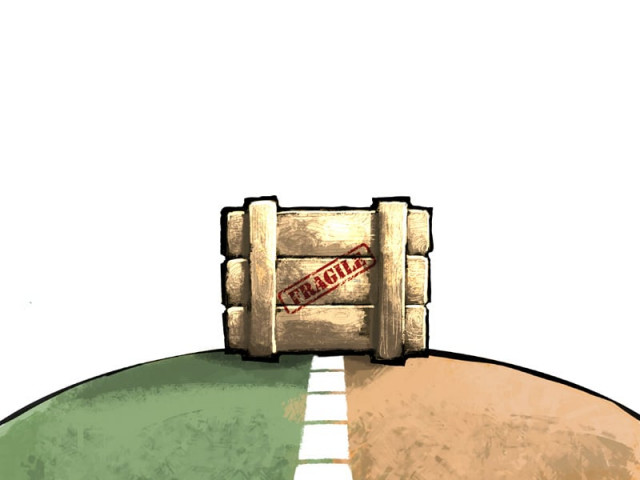Border-talk: What Indians have to say about trade with Pakistan
Indian media tends to be either silent or bullish, with trust highlighted as a key issue.

Indian media tends to be either silent or bullish, with trust highlighted as a key issue. ILLUSTRATION: JAMAL KHURSHID.
While Nawaz Sharif might be trying to convince us that India is the next trade buddy after China, it helps to ask the question: is the other side of the border’s media just as rosy eyed about potential trade as ours?
If you take a quick scan of Indian headlines, the answer is no.
The three largest English newspapers by circulation in India are The Times of India, The Hindu, and The Hindustan Times. Out of these in both The Hindu and The Hindustan Times there has been no recent reporting on any news related to trade with Pakistan.
Malala, not Nawaz, dominates the headlines.

Only the Times of India, along with its sister publication The Economic Times, had a lot more to say about trade with Pakistan. Headlines such as the “Nawaz Sharif has given ‘good signals’: India”, “With Nawaz Sharif in power, we are positive on Indo-Pak trade relation” and “Indo-Pak bilateral trade to benefit both countries” appear.
One story even discusses conducting trade in rupees not dollars.

On the whole, though, trade with Pakistan does not seem as widely covered as other news coming out of Pakistan.
Yet in contrast to the headlines, several journalists who work in the Indian media in a personal capacity seem to think trade is looking up.
Chetan Chauhan, a journalist from The Hindustan Times, for example thinks science and technology is an area worth exploring.
“Pakistan has 162 researchers for a million people as compared to 135 in India...but India has five patents for a million people, five times more than the Pakistanis.”
India could help Pakistan with improving its technological infrastructure, according to Chauhan.
Similarly, M K Venu, executive editor of The Hindu, points out that the trade relation between the nations has constantly improved throughout the 2000s.

“If trade between two nations could go up nearly five-fold during a period marked by such negative events in their relationship [Samjauta train blasts, Mumbai terror attacks], what would happen if there is relative peace and more openness in all round engagement?” said Venu.
In his article for the Indian Strategic Studies, Venu highlights a trust problem between the two nations, that when overcome could significantly reduce costs.
“A standard sea container taken through the Wagah border has a total transport cost of $391 but the same done through Mumbai-Dubai-Karachi costs close to $1,000 per container. So, one can imagine what will happen once the Wagah border becomes open to transporting items on a wider basis.”
Finally, the most positive view is held by Rahul Khana, executive president of ‘Bennett, Coleman & Company Ltd’ (BCCL). His article “Nawaz Sharif’s coming to power is an opportunity India must not miss” for the Times of India, which is owned by the BCCL, is mostly about better political relations with Pakistan but touches upon economic relations too.
“We may lament the recent slowing-down of the Indian economy, but from Pakistan’s perspective we are still on a roll. Conversely, the past decade has been pretty much a write-off for Pakistan economically and they would love to hitch their economic wagon to the Indian train, to whatever extent possible.” He wrote.
He sees economic cooperation as the new stabiliser between the countries: “Besides helping both our faltering economies, this would help lay a concrete foundation for lasting peace, capable of weathering future storms.”
So while major publications may seem to provide little as to talks with Pakistan as actually problem, several people within the Indian media can provide info otherwise.
Even so, in an update to the original article, Khana noted “Most of you feel that the scenario I’ve painted is hopelessly optimistic, that Pakistan can’t be trusted, that the ‘leopard won’t change his spots’ etc.”
Clearly then, for trade relations to improve, the trust level between the two countries is also going to have to improve.
Published in The Express Tribune, July 22nd, 2013.
Like Business on Facebook, follow @TribuneBiz on Twitter to stay informed and join in the conversation.


















COMMENTS
Comments are moderated and generally will be posted if they are on-topic and not abusive.
For more information, please see our Comments FAQ